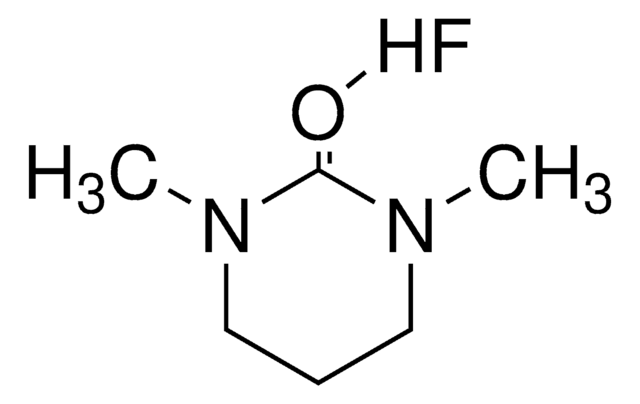8.14371
Triethylamine trishydrofluoride
for synthesis
Sinónimos:
Triethylamine trishydrofluoride
About This Item
Productos recomendados
Nivel de calidad
formulario
liquid
pH
3 (20 °C in H2O, saturated aqueous solution)
bp
70 °C/19.9 hPa
temperatura de transición
flash point 88 °C
densidad
1.00 g/cm3 at 20 °C
temp. de almacenamiento
2-30°C
InChI
1S/C6H15N.3FH/c1-4-7(5-2)6-3;;;/h4-6H2,1-3H3;3*1H
Clave InChI
IKGLACJFEHSFNN-UHFFFAOYSA-N
Categorías relacionadas
Aplicación
- Asymmetric synthesis of fluoroamines from chiral aziridines: This study explores the use of triethylamine trishydrofluoride in the synthesis of fluoroamines, highlighting its role in enhancing reaction selectivity and efficiency (Park et al., 2014).
- Recent advance in the synthesis of (1, 1-difluoroethyl) arenes: This paper discusses recent advancements in the synthesis of difluoroethyl arenes using triethylamine trishydrofluoride, contributing to the development of new fluorination techniques (Li et al., 2018).
- Quantification of hydrogen fluoride-based reagents using a bifunctional NMR internal standard: Describes the quantification of reagents like triethylamine trishydrofluoride in chemical syntheses, emphasizing the accuracy of measurement techniques (Hammond et al., 2016).
- Extensive CRISPR RNA modification reveals chemical compatibility and structure-activity relationships for Cas9 biochemical activity: This research utilizes triethylamine trishydrofluoride for RNA modifications in CRISPR-Cas9 processes, showing its potential in genetic engineering (O′Reilly et al., 2019).
Nota de análisis
Colour (visual): colourless, almost colourless
Density (d 20 °C/ 4 °C): 0.995 - 1.000
Identity (IR): passes test
Palabra de señalización
Danger
Frases de peligro
Consejos de prudencia
Clasificaciones de peligro
Acute Tox. 1 Dermal - Acute Tox. 2 Inhalation - Acute Tox. 2 Oral - Eye Dam. 1 - Skin Corr. 1A
Código de clase de almacenamiento
6.1A - Combustible, acute toxic Cat. 1 and 2 / very toxic hazardous materials
Clase de riesgo para el agua (WGK)
WGK 3
Punto de inflamabilidad (°F)
190.4 °F
Punto de inflamabilidad (°C)
88 °C
Certificados de análisis (COA)
Busque Certificados de análisis (COA) introduciendo el número de lote del producto. Los números de lote se encuentran en la etiqueta del producto después de las palabras «Lot» o «Batch»
¿Ya tiene este producto?
Encuentre la documentación para los productos que ha comprado recientemente en la Biblioteca de documentos.
Nuestro equipo de científicos tiene experiencia en todas las áreas de investigación: Ciencias de la vida, Ciencia de los materiales, Síntesis química, Cromatografía, Analítica y muchas otras.
Póngase en contacto con el Servicio técnico





![1-clorometil-4-fluoro-1,4-diazoniabiciclo[2,2.2]octano bis(tetrafluoroborato) >95% in F+ active](/deepweb/assets/sigmaaldrich/product/structures/206/487/53d52ee5-ef71-4e9a-9bc8-938b68b98d5d/640/53d52ee5-ef71-4e9a-9bc8-938b68b98d5d.png)



